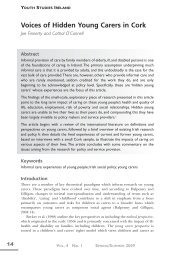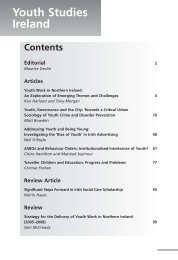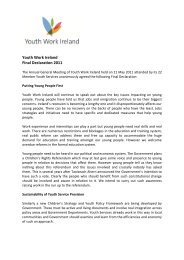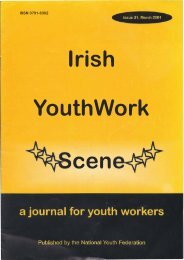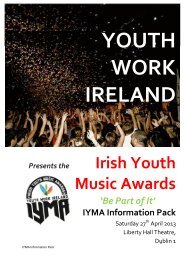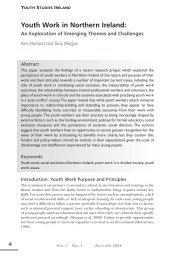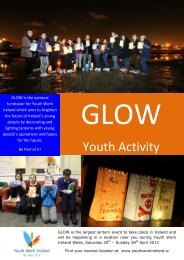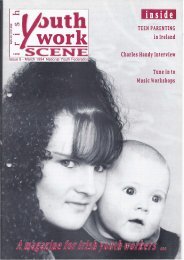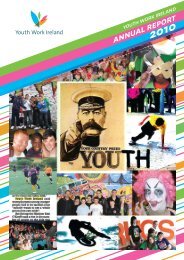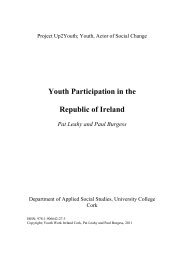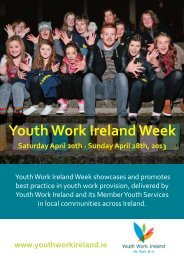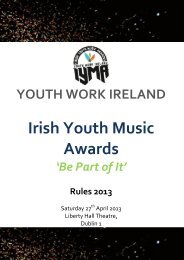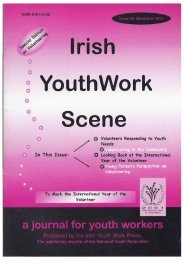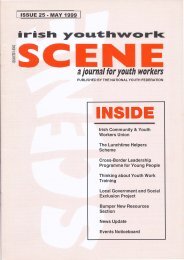Issue 45: May 2005 - Youth Work Ireland
Issue 45: May 2005 - Youth Work Ireland
Issue 45: May 2005 - Youth Work Ireland
Create successful ePaper yourself
Turn your PDF publications into a flip-book with our unique Google optimized e-Paper software.
Issn: 0791-6302 <strong>Issue</strong> <strong>45</strong>, <strong>May</strong>, <strong>2005</strong>Irish<strong>Youth</strong> <strong>Work</strong>SceneThe Gaf <strong>Youth</strong> Health CaféBeLonG TO ProjectHealth & Nutrition Activities SupplementSubstance Misuse DVD ProjectYoung People & Alcohol Video ProjectPlus......youth work resources,news & policy updatesMagazine for <strong>Youth</strong> <strong>Work</strong>ersPublished by the Irish <strong>Youth</strong> <strong>Work</strong> PressThe Publishing Imprint of the National <strong>Youth</strong> Federation
ContentsGaf Health Advice Cafe 3Family Guide to SubstanceMisuse 6BeLonG TO <strong>Youth</strong> Project 8Health & Nutrition ActivitiesSupplement 11The Good, the Bad & UglySides of Alcohol 15New Resources 17Notice Board 19Policy & Funding 21Round Up 23Production Editor: Fran BissettContributors: Michael Barron,Fran Bissett, Anne Bradshaw,John Fitzmaurice, Catherine Kaye,Diarmuid Kearney, OliviaMcGeoghLayout: Gina HalpinPrinting: Goodson PrintDisclaimer: It is open to all readersto exhange information or to put forwardyour points of view. Send innews, comments, letters or articles tothe editor. Views expressed in thisjournal are the contributor’s own anddo not reflect those of the National<strong>Youth</strong> Federation or the Irish<strong>Youth</strong><strong>Work</strong> Centre.Irish <strong>Youth</strong><strong>Work</strong> Centre20 Lower Dominick StreetDublin 1Tel: 01 8729933Fax: 01 8724183Email: fbissett@nyf.ie / ghalpin@nyf.ieWebsite: www.iywc.comTaking Careby Diarmuid KearneyNYF Chief ExecutiveWhile we frequently attempt to define the role of the youth worker, toset parameters that somehow make the job a little more manageable,we know in truth that all issues that impact on the lives of young people mustreceive some level of our attention. It is not just an option therefore, but aresponsibility for the sector to speak out on issues that limit young peoplesopportunity to act as full and active citizens or that disadvantage them in anyway.Minister McDowell with the unprecedented supported of all the larger politicalparties has proposed the introduction of what has been described as 'thegreatest single threat to the rights of young people in decades' by way of Anti-Social Behaviour Orders (ASBOs). Shame on him, and shame on all otherpoliticians who have exposed their willingness to sacrifice the rights of youngpeople for votes. The introduction of this ineffective and damaging legislationmust be vociferously resisted by youth work.There are other issues which increasingly demand our attention. Health wasidentified by young people as one of the most important issues in last yearsNYF youth poll and more extensive qualitative research is currently underwayto increase our understanding. Whatever emerges we can be sure that it willreflect a diversity of concerns. Young people are confronted daily withdemands and expectations on body image, psychological well-being, theabuse of drugs and alcohol, sexual health, diet and nutrition.It stands to reason therefore that our responses need to be equally diverse.Already we have some good examples of this. Initiatives such as health cafes,the NYCI <strong>Youth</strong> Health Programme, NYF's Drugs and Alcohol Guidelinesand innovative approaches to addiction all contribute to an evolving repertoireof responses to young people's health related needs. The responses, in turn,demand a repertoire of skills. <strong>Youth</strong> workers must be campaigners and counsellors,educators and insurance experts, mediators and mini bus drivers. Thecore of our work remains unchanged however in working alongside youngpeople to support their full, active and 'healthy' citizenship.Dealing with this complex and pressured task must be supported not just byway of skills development training but also by looking after the health of theworker. Within the <strong>Youth</strong> <strong>Work</strong> sector we must ensure that we take care ofourselves in order to be best equipped to both respond to young people'shealth related needs and to advocate for them when measures such asASBOS emerge which threaten their basic civil rights.Irish <strong>Youth</strong> <strong>Work</strong> Scene 2 <strong>Issue</strong> <strong>45</strong>, <strong>May</strong>, <strong>2005</strong>
SERV ICEPROFILEThe Gaf Health Advice Caféby John FitzmauriceIntroductionEstablished in 2002 the Gaf is an adolescent healthproject for 14 – 20 year olds, funded by the HealthService Executive, Western Region. The projectemerged through the joint working between ChildCare Services and Drug Prevention Services, whorecognised the need for a drop-in service for olderadolescents.With Galway’s well-known café culture it wasdecided to use this forum to attract young peopleonto a preventative health pathway towards reducingadolescent adversity. Promoting a holisticapproach to health the Gaf offers a safe place foryoung people to meet (both formally and informally),access information or talk to someone in confidence.The aim is to provide a non-stigmatisingvenue in the city where young people can accessservices and advice.A core team of professional people with a multi-disciplinarybackground staff the Gaf (the Gaf work inpartnership with Foroige and the Galway <strong>Youth</strong>Federation). The Gaf aims to improve young people’sawareness of health and health related issues.This is achieved by providing an adolescent friendly,safe, environment in which young people canaccess services directly and avail of “brief intervention”advice and support.Young people are active partners in the delivery ofthe service. The <strong>Youth</strong> Committee made of tenyoung people meet fortnightly and actively participatein policy formation, the development of programmesand activities and in the day-to-day runningof the cafe.Drop In ServiceThe drop in service opens on a daily basis at 1pm,Tuesday to Saturday (on Mondays it opens fromfour to six). As the week progresses the openinghours extend to respond to the need, up to 10pm onFriday’s. At present we close at 6pm on Saturday’sbut we are currently examining the feasibility ofopening a Saturday night café, providing drug andalcohol free entertainment.The café is staffed at all times on a rota basis – theremust be two adults in the building at all times andthree at weekends. For staff this is a period qualityinteraction with young people based on mutualrespect and trust. Staff need to be prepared to givetheir undivided attention, as a young person’s firstimpression of the service is crucial in determiningtheir future use.The social aspect of the project is vitally important.The need to provide alcohol free alternatives isessential. By providing a safe entertainment venuewith an emphasis on live performances we are maximisingour potential as a drug and alcohol freeentertainment venue. An Events Committee existswith the responsibility for the management of thewide variety of entertainment offered to young people(including live music, movies, art exhibitions,poetry, drama). They are involved in the planningand co-ordinating any social events that the Gaf areinvolved in.The second report on the National Alcohol Strategyidentifies the need for alcohol free alternatives andrecognises the Gaf “as an excellent example of creatinga safe space for young people. Young peoplesee the centre as a café where they can go to meetand hang out with friends listen or partake in musicand access information”.An event like the battle of the bands or art exhibitionsprovides a valuable form of self-expression foryoung people. It also allows them the opportunity toenjoy themselves in a safe environment with thesupport of their peers.Gaf <strong>Work</strong> ProgrammeTo compliment the drop-in service the Gaf has awork programme designed by the staff and youthcommittee offering a variety of information andeducational services. The Gaf adopts a social healthmodel, which incorporates a range of prevention andIrish <strong>Youth</strong> <strong>Work</strong> Scene 3 <strong>Issue</strong> <strong>45</strong>, <strong>May</strong>, <strong>2005</strong>
education strategies and offers information about awhole range of treatment options.All issues pertinent to young people’s health areaddressed so as not to stigmatise anyone attending.<strong>Youth</strong> information on issues such as alcohol and dietis available in an informal and non-intrusive way.Programmes include the Peer Education programmeand the Teenage Health Initiative which is a sexualhealth programme aiming to delay the onset of earlysexual activity.Other programmes include yoga, mentoring, dance,drama and health and beauty. These groups areattended by young people, some of who have beenreferred directly and the majority being drawn bythe drop in service.The average age of the young people who use theservice is 16.5 years. Young people attend from allareas of the city, which is the main reason why atown centre base is essential. The Gaf is a universalservice open to all young people within which thereis targeted provision for those most at risk. We donot classify young people into categories in ordernot to stigmatise them in any way.It is vital that the Gaf is not just seen as a place youcome to if you have a problem. When you call intothe Gaf it might be to read a book, take part in dramaor talk to one of the staff about a pressing issue youhave.Why Young People Use the GafYoung people use the Gaf for a variety of reasons. Itis a place where you can meet friends old and newand there is no “pressure on you to spend money”.Many enjoy the fact that that can get free milk andfruit. Inevitably anything to do with music, bandnights, acoustic nights and DJ nights prove verypopular. Recent studies indicate that a large numberof young people acknowledge talking to staff as oneof the main reasons they use the Gaf;“When I complained about some school stuff topeople here they made me see reason why thoserules are in place”.As one of our primary aims is to create an atmospherewhere young people can access support fromstaff it is recognised that good relationships with thestaff is vital to the success of the initiative. Otheractivities include reading books/magazines, gettinginformation, watching TV and taking part in programmes.The Gaf appeals to older adolescents for a numberof reasons. As young people are involved in thedecision-making processes at all levels they have asense of ownership over the service. Diversity isrespected and encouraged,“I like the way you can just be yourself andnobody will judge you on what you look like orwhat you wear”.Young people acknowledge and respect the qualityand pleasant surroundings;“I like the fact that it’s a place you can chill outand forget the problem you have in the outsideworld”….“You can do anything you want, have fun withyour friends and make friends with the staff”.Young people who access the service do not have toengage in any formal group work but there is theopportunity to do so if they wish. The environmentis vibrant and colourful. It is a quality space, whichis designed for young people in collaboration withyoung people.Voluntary and StatutoryRelationships and SupportsVolunteers play an essential role in the delivery ofthe service. Adult volunteers help out at programmelevel and also in a supervisory capacity. The Gafgives volunteers the ideal platform to share theirskills with a willing audience. Volunteers have facilitatedactivities such as guitar lessons, yoga, drama,photography and soccer.On a supervisory level they help to provide an out ofhours drop-in service in the evening and weekends.Young volunteers staff the café area in the eveningsand at weekends. As they are often the first point ofcontact for new people visiting the Gaf, they conveythe image that this is an adolescent friendly place tobe.Irish <strong>Youth</strong> <strong>Work</strong> Scene 4 <strong>Issue</strong> <strong>45</strong>, <strong>May</strong>, <strong>2005</strong>
empirical information which would detail the typesof substances most used by young people in the area.This research was conducted through the use offocus groups and also by dissemination of over 400questionnaires.The questionnaires were designed to yield informationthat would provide general information arounddrug use in Tipperary, the questions varied andincluded such questions as: who would have introducedthem to their first drug, how many drankbefore the age of 18 years old, how many felt peerpressure was an issue when it comes to substancemisuse…etc.With all of this information gathered, the MTDIcoordinator met with and discussed the idea withMr. Tom Needham, Addictions Counsellor with theSubstance Misuse Team, who was extremely energisedabout the idea and was enthusiastic to becomeinvolved with the project in terms of developing thescript and the general content. Tom informed thecontent of the film through a combination of extrapolatedexamples from general counselling work withyoung people and information gathered from youngpeople in the questionnaires.The objective of the project was to include youngpeople in every way possible, in terms of film makingskills along with general drug awareness education.All young people were involved in a meaningfulway, they had hands on input in all aspects of theproject, i.e. production stage, filming, editing…etc.To ensure they had the opportunity to use film makingequipment…etc, we worked with young peopleto develop a short film titled ‘Murder Mystery inyour Hometown’. This presented the opportunityfor young people to create their own film fromscratch, they scripted, acted in, filmed, edited andfinalised the entire piece and on the night of the officiallaunch of the Drugs Film, this short film wasalso shown on the big screen to showcase the workand skills gained by young people during the developmentof the project.Conclusionagencies not least of all, Janet Beck from GlasseyeProductions in Kilkenny, whose enthusiasm andpatience during the development of the film wereinspiring to all of us involved.Thanks most especially to all the young peopleinvolved, and in particular to Cormac English whoauditioned for the part of the main character in thefilm, Paul. Cormac delivered the script in a mostcredible performance, which is essentially theessence of the success of the project.Thanks also to Luke Moloney and Tony Black, whoplayed Paul’s friends. Thanks must also go to ourfunders, Tipperary Leader Group, who took achance in supporting the initiative and we hope theyfeel justified in their decision!!Thanks also to all our colleagues at the HealthService Executive, especially to Tom Needham,Johnny Casey, Substance Misuse Coordinator andSinead O’Mahony-Carey, Drug Education Officer.The training pack is now available for sale at theTipperary Regional <strong>Youth</strong> Services at E12.50, andall proceeds will be used to create and develop asimilar project dealing with further drug awarenessissues in the future with the MTDI. The pack is wellworth purchasing if you intend working with youngpeople, parents or the wider community in generalin terms of raising drugs awareness.For further information contact:Anne BradshawCoordinatorMid-Tipperary Drugs InitiativeTipperary Regional <strong>Youth</strong> Service17 Bank PlaceTipperary TownTel: 062 52604Fax: 062 33406Email: mtdi@eircom.netThe project was one of the most engaging worthwhileprojects conducted with the MTDI to date andis the result of over two years work in the background.Thanks are due to numerous people andIrish <strong>Youth</strong> <strong>Work</strong> Scene 7 <strong>Issue</strong> <strong>45</strong>, <strong>May</strong>, <strong>2005</strong>
The BeLonG TO <strong>Youth</strong> Projectby Michael Barron,BeLonG To Co-ordinatorPROJECTPROFILEIntroductionBeLonG To <strong>Youth</strong> Project was set-up in December2002 to work with Lesbian, Gay, Bisexual &Transgender (LGBT) young people in <strong>Ireland</strong>. Itsupports and resources young people, aged 14 – 23,to actively participate in the world around them andto make informed decisions which will positivelyimpact on their lives. As such, it is the first and onlyproject of its kind in the country.BeLonG To provides one-to-one and group supportfor young people to allow them to safely engagewith confidence building, personal development,peer support and making friends. It also affordsyoung people a space where they can experienceinclusion, acceptance, social justice, fun and safety.The project believe that youth work offers an idealopportunity for LGBT youth to address their issuesand concerns, while enabling them to participate asequal citizens in a society which would often denytheir rights.Identifying NeedsBeLonG To <strong>Youth</strong> Project was born out of an interagencyround table discussion, hosted by Out<strong>Youth</strong>,(which was a voluntary gay youth group run byyoung people and supported by Gay SwitchboardDublin) in April 2001. This discussion was convenedto explore the needs of LGBT youth. Theagencies involved were: Out<strong>Youth</strong>, OutHouse, GayMen’s Health Project, Gay Switchboard Dublin,Gay HIV Strategies, Parents Support, Union ofStudents of <strong>Ireland</strong>, National Lesbian and GayFederation and City of Dublin <strong>Youth</strong> ServicesBoard.The primary recommendation from this discussionwas to work to establish a comprehensive LGBTyouth service for the greater Dublin Area. As a resulta smaller interagency committee was establishedand set about drawing up a funding proposal to submitto the Department of Education. This group meton a monthly basis for 2 years. The work paid offhowever when, with the support of the City ofDublin <strong>Youth</strong> Services Board, the Departmentagreed to fund this youth project through the SpecialProgrammes for <strong>Youth</strong> Fund – making it the onlynew youth project funded by the Department lastyear.<strong>Work</strong> ProgrammeBeLonG To SundayThe BeLonG To <strong>Youth</strong> Project has been supportingand facilitating a meeting of LGBT young peopleeach Sunday called ‘BeLonG To Sunday’ The numbersof young people attending the group has variedfrom 15 – 35. A programme of social education andsupport is provided here to young people who inmany cases are unable to disclose their sexuality inany other environment. The group serves to positivelyaffirm all aspects of young people’s identities.It meets every Sunday at 3.30 in OUThouse,Dublin’s LGBT Community Centre, 105 Capel St.BeLonG Teen!A new under 18’s group, BeLonG Teen, has been setup for younger members of BeLonG To. LGBT peoplebetween 14 and 18 are welcome to this newgroup. BeLonG Teen is a relaxed and social groupand aims to make it easier for under 18’s to meet andmake friends their own age. The objectives andaim’s of BeLonG Teen similar to BeLonG To andthe groups are on at different times on Sundays somembers can attend both groups.At the moment BeLonG Teen meets every secondweek on the 1 st and 3 rd Sunday of each month andIrish <strong>Youth</strong> <strong>Work</strong> Scene 8 <strong>Issue</strong> <strong>45</strong>, <strong>May</strong>, <strong>2005</strong>
hopes that shortly it will meet every Sunday.The group is facilitated by Julian & Chris, twounder-18 youth facilitators and is working on a largeart piece at the moment, which will be exhibited aspart of the Pride celebrations in June as well asshowing some new photography work in The CivicOffices as part of the aLAF Festival.<strong>Youth</strong> Leadership TrainingThe project has trained and supported 6 young peopleto become group facilitators, enabling them todeliver programmes of peer education to young peopleeach Sunday. Peer support has proved to be themost effective form of affirmation and acceptancefor young people who are excluded from the mainstream.Individual <strong>Work</strong>Young people who phone or email the project oftencall in for an arranged chat with the youth worker.They talk in the café of OUThouse. Young peopleoften come for a chat before they attend one of ourgroup programmes – it’s kind of an easier first step.Young people also call in to confidentially talk aboutcertain issues that are going on for them.Exchanges with other LGBT <strong>Youth</strong> GroupsLast summer BeLonG To participated in a three-wayexchange with similar LGBT youth groups inManchester and Wigan. Because The BeLonG To<strong>Youth</strong> Project is the only LGBT youth project in thecountry this opportunity provided a valuable educationaland affirmational opportunity for the membersof the project. This exchange proved to be asubstantial piece of work. The two groups fromEngland came to Dublin in July for 7 days andworked with BeLonG To on an extensive programme,which was designed by Irish and Englishyoung people in conjunction with their youth workers.In August The BeLonG To <strong>Youth</strong> Project travelledto Manchester and Wigan for the second leg,with a programme, which built on the work fromJuly and included performing as a group inManchester and exhibiting artwork in a gallerythere.Multi-cultural workThe LGBT community is becoming ever increasinglymulti-cultural and as a reflection of this BeLonGTo has worked with a significant number of‘Unaccompanied Minors’ – who are young nonnationalswho are seeking asylum in <strong>Ireland</strong>. Theproject has had to adapt to working in a differentway with these young people, by providing moreone-to-one work, by advocating on their behalf andby working with refugee legal and social work services.Playback DramaBeLonG To worked together with a Playback Dramateacher on a 10-week project which was based onthese young people telling stories about themselves.The idea was to allow young people who have generallybeen unheard to have their voice heard and tofeel accepted. This project was intensive, workingwith a small group of young people (6) and was digitallyrecorded and photographed. The young peopleinvolved reported that they had a lot of fun duringthe process and that it had a positive affect on theirself-esteem. We plan to do further Playback workwith other selected young people in the forthcomingyear.DanceYoung people were facilitated in a six-week danceproject, which culminated in a performance in frontof the larger group. We envisage that this was thebeing of a process which will be built on in thefuture.PhotographyBeLonG To are presently working on a self portraitphotography project. <strong>Work</strong>ing with a photographerto facilitate young people in taking photographs ofthemselves and their lives, isa process which allowsthem to examine issues such as self image, selfesteem and body image. BeLonG To believes thatthese are particularly important issues for LGBTyoung people and this project allows young people aspace where they can challenge their own (oftennegative) self image and receive positive affirmation.This project culminated in a major exhibitionwhich was featured on RTE News and in the nationalprinted press.Video and Magazine MakingYoung people were facilitated in a month longprocess of video making in partnership withLiberties College Media Department. The resourcewill act as introduction to the work of BeLonG To toyoung people who come for the first time. Youngpeople were facilitated by a journalist in the creationof a magazine which acts as a platform for LGBTIrish <strong>Youth</strong> <strong>Work</strong> Scene 9 <strong>Issue</strong> <strong>45</strong>, <strong>May</strong>, <strong>2005</strong>
young people’s creative talents through the publishingtheir poems, prose and memoirs.Training to <strong>Youth</strong> <strong>Work</strong>ers and other <strong>Work</strong>ersBeLonG To has provided training on working withLGBT young people, creating safer environmentsand policy development to youth workers, teachers,parents, social workers and other health professionals.This work is on-going.Strength in Diversity Project.BeLonG To worked in partnership with Sustainable<strong>Ireland</strong>, ECO-UNESCO, Sports Action againstRacism, The Separated Children’s Project and PaveePoint in a project exploring discrimination and promotingdiversity among minority young people andamong young people in general. This project wasinitiated by Sustainable <strong>Ireland</strong> in January and culminatedin a residential for young LGBT people,young Travellers and young Asylum Seekers inSeptember.Following this residential a youth forum was alsoheld where young participants presented materials totransition year students from schools in Dublin. Thiswork is on-going and has resulted in a strong senseof solidarity among young people from the variousprojects and among the projects themselves.PublicationsBeLonG To are presently completing a ConsultationTool Kit for working with LGBT young people withthree LGBT youth groups in Manchester, Leeds andWigan. The kit will offer a best practice guide toworking with LGBT young people and to consultingthem about the needs and concerns. BeLonG Tohosted the three youth groups for three days inJanuary of this year and were hosted by theManchester group in April. The publication will belaunched soonLGBT Affirmation Poster and BookletThis project began in <strong>May</strong> 2003 and included alaunch of the resources in The Equality Authority onNovember 26th. The project was developed inresponse to a need identified by young LGBT membersdue to the isolation they experienced beforefinding supports. Resources are being distributed toschools and community centres nationwide and theprogramme is funded by Leargas with support forprinting costs from The Gay Men’s Health Project.1,500 posters and 3,000 booklets were posted toevery school in the country through the Institute ofGuidance counsellors. The National <strong>Youth</strong> Councilof <strong>Ireland</strong> sent a further 250/ 750 to youth projectsaround the country, while The City of Dublin <strong>Youth</strong>Services Board sent a similar number to its affiliates.The response from individual guidance counsellors,teachers, principals and youth workers has beenwonderful. Through the generosity of the Gay Men’sHealth Project, a further 2,000 posters and 20,000booklets were sent out in response to requests fromschools and youth projects. A second launch of thematerials took place in Cork in partnership with TheSouthern Gay Men’s Health Project on 29 March 29,which will help reach more schools in The South.It is of course up to individual schools how theychoose (or if they choose) to use the poster & bookletand no doubt the materials have not appeared inmany schools. That is why young people and othersare encouraged to ask their local schools about themand this has worked with posters and bookletsappearing after in some schools that have been challengedabout them.Young Women’s GroupBeLonG To are in the process of setting up a specificyoung women’s group and to date have had tworeally well attended consultation evenings withwomen from the community. The project has alsotrained two young women in group facilitation –these young women will be attended further trainingin Manchester in March - and hopes to have thisgroup up and running in the very near future.For further information on theBeLonG To <strong>Youth</strong> Project and itswork programme please contact:Michael BarronBeLong To Co-ordinator105 Capel StreetDublin 1Tel: 01 8734184Email: belongto@eircom.netIrish <strong>Youth</strong> <strong>Work</strong> Scene 10 <strong>Issue</strong> <strong>45</strong>, <strong>May</strong>, <strong>2005</strong>
Health & Nutrition Activities SupplementHealth Promotion Summer ProjectBy Catherine KayeINTRODUCTIONThe summer is approaching and its time to startplanning your summer programmeso why not use thetheme of health to get youfocused? Whether you plan onrunning weeklong summer projectsor a series of one day programmesyou will find lots ofideas in this issues programmessupplement. Health is a hugetopic so this supplement will focus on activitiesthat introduce theme of health and get young peopleto think about what health means to them andthe types of lifestyle choices they make.“HEALTH BLOCKS”Aim: To look at the barriers to a healthier lifestyleand for a peer group to participatein developing health strategies thatare appropriate to the group.Age: 12+Materials Needed: Paper, Pens & A boxMethod:Each young person completes the followingsentence on a piece of paper “I want tochange my lifestyle & become more healthybut the one thing that stops me is . . . ”When completed each statement is placed inthe box.Each young person then picks out a statement that is not his/her own and gives asuggestion that might overcome the barrierthat prevents that person from becominghealthier.Allow time for group discussion of eachsuggestion.“THE HEALTHY QUESTION?”Aim: For young people to take part inauditing a sample of their peers eatinghabits and to critically evaluate them.Age: 12+Materials: Flip Chart & MarkersMethod:This activity works well if you have a largegroup of young people taking part in a summer programme or summer project that isbeing run over the course of a week.Form a steering committee of about 6 youngpeople.The group then designs a questionnaire fortheir peers regarding their eating habits. Letthe young people come up with their ownquestions and design how they will carryout the survey. Will it be a page handed outfor the population to fill in themselves, willthey ask questions and tick relevant boxes orwill they simply ask the young people to“Open their Lunch boxes” and note downthe contents?Once they group have tabulated the resultsthey can be presented in a number of creativeways e.g. you could have the young peoplecollecting bar, crisp wrappers and fizzydrinks cans. These can then be used to give avisual representation of what the populationconsume in a week or a single day by creatinga junk food mountain!HEALTHY EATING DISCUSSIONAim: To encourage young people totake part in a critical discussion focusingon healthy eating.Age: 12+Materials: Flip Chart Paper & MarkersIrish <strong>Youth</strong> <strong>Work</strong> Scene 11 <strong>Issue</strong> <strong>45</strong>, <strong>May</strong>, <strong>2005</strong>
Method:Divide the young people into two groups.One group must put together points thatagree with the following statements and theother group points that disagree:“Many schools are introducing healthylunch guidelines which is great”“It costs money to be healthy”“The media has a lot to answer for!”Groups can discuss the points they come upwith and chart them on flip chart paper.The two groups take part in a discussionfacilitated by the youth leader, as the youngpeoples opinions change they can choose tojoin the opposing group.HEALTHY HEADSAim: To encourage youngpeople to think about healthand what it means to them,and to create a visual imageof this.Age: 12+Materials: Round Balloon, Cling Film, Paint,Masking Tape, Newspaper & Paper Mache Paste(Mix 1 part flour with about 2 parts of water untilyou get a consistency like thick glue. Add morewater or flour as necessary. Mix well to get out allthe bumps. Add a few tablespoons of salt to helpprevent mold!)Method:Start by discussing the activity with the group.Explain how to make the heads but also spend timediscussing what heath means t othem and how they are going to representthis with their head. Forexample they could make a head thatlooks like an orange or a caricatureof someone running at speed with their featurescatching up with the head, or someone physicallyglowing light a light bulb with health!Cover the work surface well.Blow up the balloon and tie it closed. Find abowl or cup the balloon can sit in.Cover the cup or bowl with plastic wrap sothe paper mache does not stick to it.Tear several newspaper pages into strips 1inch wide and about 6 - 8 inches long. Setthem aside.Use a large bowl to prepare the paper machepaste.Dip the newspaper strips into the glue andspread them onto the balloon. Completelycover the balloon, except for the area whereit is sitting in the cup.Set aside and let this first layer dry.Once the first layer is completely dry, usevarious supplies to make the facial featureson the balloon as desired. Make a nose, ears,thick eyebrows, lips, etc. Use cardboard,food containers, foil.Use masking tape to hold everything inplace.Add at least two more layers of paper macheto the balloon. Allow each layer to dry completelybefore putting on the next layer. Onceit is dry, pop the balloon and remove itthrough the opening left at the bottom.Paint and decorate the mask or face asdesired. Add hair using wool, thin scraps ofmaterial etc.“MYTHS OR FACTS?”Aim: To dispel some myths andfacts around food and healthyeating.Age: 10 +Method:The youth leader reads out the followingstatements:If the young person thinks it is a fact theystand to the left side of the room, it theythink it is a myth they stand to the right, ifthey are unsure they stand in the middle.Before the leader gives the correct answerthey can take the time to allow the youngpeople to individually explain why theychose to stand where they did.“Vegetarian foods are the healthier option”Myth – No food is good or bad what is important isthe balancing of the types of food you eat from thefive food groups. Moderate amounts of meat, fishand chicken form part of a well balanced diet.“Eating carbohydrate foods like bread, potatoes,Irish <strong>Youth</strong> <strong>Work</strong> Scene 12 <strong>Issue</strong> <strong>45</strong>, <strong>May</strong>, <strong>2005</strong>
ice and pasta will make you put on weight.”Myth – These foods will fill you up and give youlots of energy. The problem withweight gain tends to come from usingtoo much fat in the cooking e.g. chipsare far more fattening than boiledpotatoes, or from adding fatty sauces.“Skimmed milk has less protein and calcium thanwhole milk.”Myth – All milk is a good source of calcium andprotein, when skimmed milk is made only the fat isremoved.“An apple a day keeps the doctor away.”This is a bit of a trick question; we need to eat 5 portionsof fruit and vegetables a day, an apple onlycounts as one. Try to include a variety of fruit, saladand vegetables in your daily diet.“Potatoes can be counted towards the 5 portionsof vegetables a day.”Of course potatoes are a good source of vitaminsand minerals but their main benefit is that they are agood source of carbohydrate so they fit into thisfood group.“Vitamin and mineral supplements are needed tomake sure we get enough.”Myth – Eating a well balanced diet willgive you all the vitamins and mineralsyou need, buying supplements can beexpensive and if too many are taken can be dangerous.“Frozen foods count towards the five portions offruit/veg a day.”Fact – frozen foods such as corn, peas and broccoliall retain their vitamins and mineral when frozenand so count towards the five portions needed a dayDevelopment: Continue the debate of other commonstatements or proverbs about food with yourgroup.“HEALTHY HELEN ! ?”Aim: To engage young people in anactivity in which they identify healthchoices and the positive and negativephysical effects these can have on ayoung person.Age: 10+Materials: Flip chart paper, Markers, Paint &Material GlueMethod:Stick large sheets of paper together to makeit as tall as a person. Divide the group in twogive each paper.One member of the each group lies down onthis sheet and another group member drawsaround them.This drawing is going to become a character.The character must represent A) a healthyyoung person who makes positive choices interms of smoking, alcohol, nutrition exerciseetc and B) an unhealthy young person whohas made unhealthy choices.Before each group begins they must askthemselves the following questions:Is the character male or female?What is your characters name?What age are they?What do they look like?Where are they from?What type of clothes do they wear?What are their hobbies?What kind of personality do they have?What do they look like physically, hair, nails, andteeth?How do their physical characteristics representtheir health?The groups then use scraps of material to dress thecharacter. They must draw on their physical featuresand any otherimages thattell us more about theperson. Theymust try notto write any words onthe sheet but to useimagery to communicate their ideas for example ifthe character has bad breath draw the fumes comingout of their mouth etc.Irish <strong>Youth</strong> <strong>Work</strong> Scene 13 <strong>Issue</strong> <strong>45</strong>, <strong>May</strong>, <strong>2005</strong>
QUICK IDEAS!HANDY WEB SITESGrow an organic garden and use the produceto create healthy meals.Have young people goaround to the differentworkshops during yoursummer project with plattersof exotic fruit for theparticipants to taste.As part of a cookery programme have theyoung people make arecipe book of alltheir favorite healthyrecipes.For more details please contact the followingwebsites:Department of Health andChildren www.doh.ieHealth Promotion Unit www.healthpromotion.ieBord Bia www.bordbia.ieBord Iascaigh Mhara (BIM) www.bim.ieSafe Food Online www.safefoodonline.comHealth Promotion activities http://www.healthysteps.ieWeb site for young people on alcoholhttp://www.unlocked.ieDrugs information http://www.drugsinfo.ieHave a giant family picnicday, set up foodstations where people goaround and make up theirown lunch from a selection of healthyoptions. You can colour code the tables. e.g.the red table has tomatoes, red peppers andstrawberries!Encourage groups to increasetheir participation in daily exerciseby organising communitywalks. The young people can plan theroute themselves and monitor increase in thegroups’ fitness levels.For further information please contact:Catherine KayeArts & Programme OfficerNational <strong>Youth</strong> Federation20 Lower Dominick StreetDublin 1Tel: 01 8729933Fax: 01 8724183Email: ckaye@nyf.ieContact your local health promotionofficer or organise avisit from a dental nurse, localGP, dietician etc.Irish <strong>Youth</strong> <strong>Work</strong> Scene 14 <strong>Issue</strong> <strong>45</strong>, <strong>May</strong>, <strong>2005</strong>
‘The Good, The Bad & The Ugly Sides ofAlcohol' Video/DVD Projectby Navan Young People's Development ProjectBACKGROUNDNYPD is a one of An Garda Siochana SpecialProjects based in Navan in Co. Meath. It is in operationsince November 1999. NYPD stands forNavan Young People's Development Project. Theproject works with young people aged between tenand eighteen years in the Navan area. As with allGarda Projects young people are referred onto theproject by the local statutory and voluntary agencies.In 2003 and 2004 the media was once again highlightingteenage alcohol consumption in <strong>Ireland</strong>. Onthe 4th of September 2003 the Daily Mirror had anarticle entitled 'Hungover <strong>Ireland</strong>'. A large sectionof the article focused on the fact that Irish fifteenand sixteen year olds are Europe's biggest bingedrinkers. The Irish Independent ran an article on the10th of September 2003 on the Junior Cert results.Part of the article was a true/false quiz on 'youngstersand alcohol'In conjunction with the media blitz tragic eventsinvolving young people and alcohol had brought theissue into the homes of ordinary families. Publiclyand privately the topic was up for discussion.NYPD applied to the Irish <strong>Youth</strong> Foundation for agrant to make a video and accompanying leaflet on'Young People and Alcohol'.PROJECT DEVELOPMENTParticipants wanted an opportunity to research thetopic for themselves, to voice their own opinionsand to respond to what they felt was an unfair criticismon behalf of the media of their genre. Thevideo was worked on over a ten- month period. Itwas to be akin to a prime time documentary. Factswere to be dispersed with stories, music and interviews.Along with Shay Casserly (local film maker)participants filmed young people drinking and fighting.The group also carried out a questionnaire in a localpost primary school. The results from the sampledsurveyed:28% of 13yr olds are drinking alcoholregularly48% of 14yr olds are drinking alcoholregularly70% of 15yr olds are drinking alcoholregularly93% of 16 yr olds are drinking alcoholregularlyThe survey showed that young people can afford todrink because of part time jobs, and pocket moneyfrom parents. Accessing alcohol is not a problem.Young people reported that they know the offlicences that will sell alcohol to them and there isalways an older person willing to buy it for them.Participants researched statistics on teenage drinking.They wrote to and subsequently interviewedpoliticians, nurses in Accident and Emergency,Counsellors from the Rutland treatment Centre inDublin, Publicans, Gardaí, mothers, young people,teenagers and adults with alcohol addiction, HealthPromotion Officers, taxi drivers etc.Irish <strong>Youth</strong> <strong>Work</strong> Scene 15 <strong>Issue</strong> <strong>45</strong>, <strong>May</strong>, <strong>2005</strong>
Participants were seeking answers as to why theabove thought that alcohol and Irish adults andyoung people had such a poor and at times damagingrelationship.Participants edited their work and chose music ofrelevance to place over some of the features on thevideo. The accompanying leaflet was to be somethingof practical use to young people. The groupdesigned the leaflet themselves. On the leaflet thereare points about safe drinking and important contactnumbers.LAUNCHLocal Deputy Damien English launched thevideo/dvd and leaflet in <strong>May</strong> 2004. The productionwas called 'The Good, The Bad & The Ugly Sides ofAlcohol'. All relevant statutory and voluntary agencieswere invited along with the families of participants.The launch was very much led by the youngpeople who were the main speakers on the day.From their perspective it is not enough for the mediato focus on the perils of underage drinking whenadults are so flawed in this area themselves.At the launch the group stated that the national problemof celebrating and or commiserating with adrink is one that teenagers have an excellent grasp ofand modelled for them to such a high standard byadults.CONCLUSIONSParticipants found from their interviews that drinkingto forget problems, to feel a high, to relax arereasons that both adults and young people gave fordrinking alcohol. Telling young people about cirrhosisof the liver etc is not going to encourage themto stop consuming alcohol. It does not stop adults sowhy do adults think it will have an effect onteenagers.Young people also stated that they would still drinkeven if there were a drop in centre, youth club to goto. They would attend the activities but would drinkbefore or after them. Somewhat similar to adultsgoing for a drink after a round of golf, the theatreetc.The main point of the video was to turn the focusback onto the adults. Participants were not abdicatingtheir own responsibilities; they know excessiveconsumption of any substance can lead to poorchoices and lifelong consequences.However if adults in <strong>Ireland</strong> do not see a problemwith their own relationship to alcohol then they needto abstain from lecturing their youth until the pennyfinally drops. All young people interviewed for thisproject were under eighteen years old and all havebeen in public houses at some stage.For further information on theproject please contact:Olivia McGeoughNavan Young People'sDevelopment ProjectCommunity Resource CentreFairgreenNavanCo. MeathTel: 046 9072575Fax: 046 7902576Email: nypd.project@oceanfree.netIrish <strong>Youth</strong> <strong>Work</strong> Scene 16 <strong>Issue</strong> <strong>45</strong>, <strong>May</strong>, <strong>2005</strong>
New ResourcesADOLESCENT HEALTH &RELATIONSHIPSA Study of Sexual Health <strong>Issue</strong>s,Attitudes and Behaviours:The Views of Early School LeaversBy Paula <strong>May</strong>ock and Tina ByrneReport that presents the findings from a study of thesexual behaviours, attitudes and beliefs of youngpeople who leave school early or are ‘at risk’ ofearly school leaving. Research into the sexual livesand behaviour of young people has been neglectedin an Irish context, and we are currently know relativelylittle about the ideas and expectations thatyoung people hold about the knowledge that informstheir beliefs about sexual behaviour and sexualhealth. This research set out to talk to young peopleabout their romantic and sexual relationships and togain access to their experiences and views on arange of issues related to sexual health.You Can Talk to Me (DVD)Communicating with your childBy Crisis Pregnancy Agency‘You can talk to me’ is in DVD form and has beendeveloped by the Crisis Pregnancy Agency to helpparents in communication with their children onsexual health and relationships.Promoting Positive Adolescent Sexual Health &Preventing Teenage Pregnancy:A Review of Recent Effectiveness ResearchBy Deirdre FullertonReview commissioned by the Crisis PregnancyAgency to inform their work in the area of preventionof crisis pregnancy. The review commenceswith a brief description of the current epidemiologicaldata on teenage pregnancy and adolescent sexualbehaviour in <strong>Ireland</strong>. This is followed by ananalysis of current understanding of the antecedentsfor early sexual initiation, teenage pregnancy and/orunprotected sexual intercourse. The review concludeswith recommendations for health, education,health promotion and social services, and suggestsareas for further research.MENTAL HEALTHQuality in Mental Health - Your ViewsA Report on Stakeholders Consultation onQuality in Mental Health ServicesBy Mental Health CommissionThe Mental Health Commission, established underthe Mental Health Act 2001, is an independent statutorybody. One of its statutory duties is to promote,encourage and foster high standards in the deliveryof mental health care. In order to discharge thisresponsibility, the Mental Health Commission plansto develop and implement a quality framework formental health services in <strong>Ireland</strong>. The frameworkwill be used by the commission to support continuousimprovement in the quality of mental healthservices.VOLUNTEERINGTwo Paths, One PurposeBy Voluntary Action in <strong>Ireland</strong> North & SouthBook which sets out to make a direct comparisonbetween the voluntary sector in Northern <strong>Ireland</strong>and the Republic on <strong>Ireland</strong>. It specifically aims tomap the voluntary sectors, north and south, settingthem in the border framework of the British Islesand the European Union. To set the historical contextfor the development of the two sectors, outlininghow their paths converged and diverged from1922 to 2000 and to draw overall conclusions, lessonsand issues arising. This will return to the keyquestions facing the voluntary sector in both parts ofthe island and how they can learn from each other toface common challenges.Houses of the OireachtasJoint Committee on Arts, Sport, Tourism,Community, Rural and Gealtacht AffairsVolunteers and Volunteering in <strong>Ireland</strong>Irish <strong>Youth</strong> <strong>Work</strong> Scene 17 <strong>Issue</strong> <strong>45</strong>, <strong>May</strong>, <strong>2005</strong>
The Special Olympics highlighted the role of thevolunteer in Irish Society perhaps in a more meaningfulway than either the White Paper or the“Tipping the Balance Report” The Joint Committeewere conscious of the perceived lack of progress inthe field since those publications and felt the need toadvance “economic” arguments for the support ofvolunteering given the perceived costs to theExchequer previously demonstrated.YOUNG PEOPLE & IDENTITYLife StoriesExploring Identity with Young PeopleBy YARDLife stories is a new educational activity pack thatgives a voice to young people from a diverse rangeof minority groups in <strong>Ireland</strong>. The young people’sstories from the backbone of the pack. These storiesare supported by group work, simulation games,drams and art activities, which enable young peopleto explore identity in <strong>Ireland</strong> and around the world.YOUNG PEOPLE & VIOLENCEJuvenile Violence - Stories and PathsBy Fundacao da JuventudeStudy examining the relative lack of understandingof the facts involved in the phenomenon of youthviolence in Europe. By analysing and learning aboutthe stories and paths of youths placed in educationalcentres it sets out external variables that characterisetheir social and economic origins, their schoollife and passage through various control andauthories, as well as their living realities and itsmeaning within their own context. In this way it waspossible to understand the meaning that the youthsYOUTH POLICYthemselves attribute to their own acts of violence.The Office of the Ombudsman for ChildrenInternational Learning and Priorities for<strong>Ireland</strong>By Anne ColganThe campaign to establish an Office of Ombudsmanfor Children in <strong>Ireland</strong> dates back to 1995. Over theintervening years, the Children’s Rights Alliance, acoalition of 75 Irish non-governmental organisationsconcerned with the rights and needs of children, hascampaigned strongly for this Office. This report isbroken down into three chapters. Chapter 1 of thereport describes the feedback form Ombudsman’sOffices about the broad strategies which the haveemployed to achieve their mission, and which theyconsider to have been very important for success.Chapter 2 provides an account of matters that theIrish contributors believe should be addressed by thenew Ombudsman in the first twelve to eighteenmonths of office and Chapter 3 contains the viewsof the Ombudsman (and some Irish contributors)about how the office of Ombudsman should operate.Consultation Document for a Recreation Policyfor Young People in <strong>Ireland</strong>By the National Children’s OfficeThe NCO is currently developing a recreation policythat will be aimed at young people of secondardschool age. The policy will deal with recreation porgrammesand facilities that are funded by theGovernment. In this consultation document reasonsfor developing the policy are set out as well as theprinciples and objectives that should underpin thedevelopment of the recreation policy.All of these titles and others on related topicsare available ON LOAN (NOT FOR SALE) toIYWC members. The IYWC is an official salesagent in the Republic of <strong>Ireland</strong> for CombatPoverty, DEFY, Directory of Social Change,NYCI, Nightshift Publishing and Russell HousePublishingFor further information and to request any ofthe resources on loan please contact:Fran Bissett / Gina HalpinIrish <strong>Youth</strong><strong>Work</strong> CentreNational <strong>Youth</strong> Federation20 Lower Dominick StreetDublin 1Tel: 01 8789933 Fax: 01 8724183Email: fbissett@nyf.ie / ghalpin@nyf.ieWebsite: www.iywc.comIrish <strong>Youth</strong> <strong>Work</strong> Scene 18 <strong>Issue</strong> <strong>45</strong>, <strong>May</strong>, <strong>2005</strong>
Notice Board“Drugs: <strong>Issue</strong>s and Experiences”Date: Saturday 11 June, <strong>2005</strong>Venue: All Hallows College, Dublin.Time: 9.30am-4.<strong>45</strong>pm.Our principal speakers for the day are:Dr Des Corrigan (School of Pharmacy, TCD andChair of the NationalAdvisory Committee onDrugs) who will give a brief overview of drug types,effects and pharmacology.Paul Delaney (COAIM - Council for AddictionInformation and Mediation) who look at the use ofskills such as motivational interviewing when workingwithdrug users and their families.Young people in recovery and representatives fromfamily support groups will also share their personalexperiences.For further information & costs:Community Awareness of Drugs31 Central Hotel ChambersDame CourtDublin 2Tel: 01 679 2681Advanced Class-Communicating Effectivelywith your VolunteersDate: Friday 30 September, <strong>2005</strong>Time: 10.00am – 4.00pmVenue: Coleraine House, Dublin 7Trainer: Rick Lynch, Lynch Associates, Seattle,USAThis extremely practical one-day workshop isdesigned to look at strategies for effective communicationwith volunteers. It will also cover areas onhow frequently should you contact your volunteers,how to give them bad news and what are the methodsfor communicating.Cost: E75.00 Volunteering <strong>Ireland</strong> members andE100.00 non-membersRecruiting & Keeping Management CommitteesDate: Saturday 22 October, <strong>2005</strong>Time: 10.00am – 4.00pmVenue: Coleraine House, Dublin 7Trainer: Sheila CahillThis is a one day course which is aimed at everyonewho is interested in recruiting new members fortheir committee and in retaining existing committeemembers. It also looks at the role descriptions forcommittee members, how to develop effective &appropriate techniques for recruitment and to understandwhat elements enhance retention of committeemembers.Cost: E75.00 Volunteering <strong>Ireland</strong> members andE100.00 non-membersVolunteer Support and SupervisionDate: Thursday 17 November, <strong>2005</strong>Time: 10.00am – 4.00pmVenue: Coleraine House, Dublin 7Trainer: Nancy NunezIt is a one day course which is aimed at everyonewho is responsible for managing volunteers. It isuseful for any organisation that is interested inimproving methods that help to retain volunteersand encourage good performance. It also looks atareas how to develop appropriate and effectivesupervision structures and to develop strategies fordealing with disciplinary issues.Cost: E75.00 Volunteering <strong>Ireland</strong> members andE100.00 non-membersFor further information please contact:Volunteering <strong>Ireland</strong>Coleraine HouseColeraine StreetDublin 7.Tel: 01 8722622Email: info@volunteeringireland.comWebsite: www.volunteeringireland.comIrish <strong>Youth</strong> <strong>Work</strong> Scene 19 <strong>Issue</strong> <strong>45</strong>, <strong>May</strong>, <strong>2005</strong>
Policy in Practice and Drugs <strong>Work</strong>Developing a strategy and policy for dealingwith the drugs issue in out-of-school settingsDate: Thursday 13 & Friday 14 October, <strong>2005</strong>(Sligo), Thursday 24 & Friday 25 November, <strong>2005</strong>(Waterford)Time: 10.00am – 5.00pmVenues: Sligo & WaterfordThis is a two-day training, which is based on theSupport Pack for Dealing with the Drugs <strong>Issue</strong> inOut-of-School Setting, revised and produced by theNational <strong>Youth</strong> Health Programme in 2003. Thecourse offers workers from both statutory and <strong>Youth</strong><strong>Work</strong> settings an approach for dealing with theDrugs <strong>Issue</strong>s from an organisational perspective, theprimary focus of this course is to facilitate and supportworkers towards the development of an organizationalstrategy and Drugs policy for Out-of-School settings.Cost: E100.00 (covers coffees, lunches and coursematerials)What’s it All AboutAlcohol and young peopleDate: Thursday 3 & Friday 4 November, <strong>2005</strong>(Galway), Thursday 1 & Friday 2 December, <strong>2005</strong>(Limerick)Time: 10.00am – 5.00pmVenues: Galway & LimerickThis two-day training course, which is aimed topresent a rationale for addressing the alcohol issuewith young people. It will highlight current researchfindings and issues of good practice. It will alsoexplore some creative methodologies in addressingthis issue and to examine the current legislativeimplications in relation to the alcohol issue andyoung people.Cost: E100.00 (covers coffees, lunches and coursematerials)Opening RoundAn introduction to working withdifferent groupsDate: Friday 7 October <strong>2005</strong>Time: 10.00am – 5.00pmVenue: DundalkThis is a one-day introductory course that explores arange of skills and strategies for working with differentgroups. These include skills in relation to presenting,chairing meetings and facilitating groups.The course is targeted at <strong>Youth</strong> & Community<strong>Work</strong>ers/Volunteers, Staff in Vocational TrainingSettings, Health Education & Health PromotionPersonnel and other workers who work directly withyoung people.Cost: E50.00 (covers coffees, lunches and coursematerials)Smoking - Awareness and CessationDate: Friday 23 September, <strong>2005</strong>Time: 10.00am – 5.00pmVenue: CorkOne day training course, which aims to raise awarenessof participants around the issue of smoking andyoung people. It will also offer an insight into smokingcessation and the strategies for providing supportto young people to stop smoking.Cost: E50.00 (covers coffees, lunches and coursematerials)Good Habits of MindA mental health initiative for those workingwith young in out-of-school settingsDate: Tuesday 15 & Wednesday 16 November,<strong>2005</strong> (Dublin), Tuesday 6 & Wednesday 7December, <strong>2005</strong> (Navan)Time: 10.00am – 5.00pmVenues: Dublin & NavanThis two-day training course, which aims to examinehow the issue of mental health impacts on youngpeople. It will also offer participants an opportunityto explore issues of good practice from a worker andan organisational perspective. Procedures aroundreferral will also be explored in detail.Cost: E100.00 (covers coffees, lunches and coursematerials)For further information on the abovethree events, please contact:National <strong>Youth</strong> Health Programme3 Montague Street, Dublin 2Tel: 01 4784122 Fax:01 4783974Email: nyhp@nyci.ieIrish <strong>Youth</strong> <strong>Work</strong> Scene 20 <strong>Issue</strong> <strong>45</strong>, <strong>May</strong>, <strong>2005</strong>
Policy & FundingTAOISEACH LAUNCHES NEWCOMMUNITY AND VOLUNTARYACTIVITY TASKFORCEAt The Wheel’s annual conference in AprilTaoiseach Bertie Ahern announced a new taskforceto promote Community and Voluntary activity.Paying tribute to The Wheel on the scope and depthof its development, the Taoiseach highlighted thesignificant contribution the Community andVoluntary Sector makes to the economy and societyas a whole.The Taoiseach said he envisaged the task force havinga dual role: producing specific recommendationsand stimulating debate and discussion on this “challengewhich concerns us all”. It is expected the taskforcewill be in existence for six months with itscomposition and terms of reference to be announcedin the near future.EDUCATIONALLY DISADVANTAGED TOBENEFIT FROM NEW PACKAGE OFSUPPORTSThe Minister for Education and Science, MaryHanafin T.D., has announced that more targeted supportswill be provided across the education systemunder the new action plan for tackling educationaldisadvantage.The new framework is the result of a full review ofthe measures that have been put in place to supportpupils from disadvantaged areas over the last twodecades and will build on the success of existingprogrammes, while addressing the issues that havediluted the overall effectiveness of some measures.Outlining some aspects of the new approach, theMinister explained that“under the new plan, better procedures will be putin place for identifying the levels of disadvantagein our schools, to ensure that extra supports aretargeted at those that need them most.”A single integrated programme of supports forschools with concentrated levels of disadvantagewill be put in place, which will bring together, andbuild upon, the existing variety of schemes and initiatives.The new framework will be introduced ona phased basis starting in the next school year andwill involve an additional annual investment of€40m on full implementation. It will also involvethe provision of some 300 additional posts acrossthe education system generally. Some of these postswill be used to provide smaller class sizes in targeteddisadvantaged schools.Other measures will include:Improving literacy and numeracy byexpanding access to successful initiativessuch as the Reading Recovery ProgrammeProviding home school community liaisonteachers to more disadvantaged schoolsEncouraging greater cooperation betweenprimary and post-primary schools in disadvantagedareas.Funding to schools to provide a mix of bothacademic and non-academic supports forchildren during and outside of school-timeProviding extra supports for principals indisadvantaged schools to enable them toimprove planning at local level and ensurethat the extra resources being provided leadto better outcomes for pupilsEncouraging better retention of teachers indisadvantaged schools, not only by providingsmaller class sizes, but also throughaccess to enhanced professional development.There will also be a new scheme ofpaid sabbatical leaveFor further information contact:Department of Education & ScienceMarlborough StreetDublin 1Tel: 01 8896400Email: info@education.gov.ieIrish <strong>Youth</strong> <strong>Work</strong> Scene 21 <strong>Issue</strong> <strong>45</strong>, <strong>May</strong>, <strong>2005</strong>
MINISTER ANNOUNCES ALMOST E2M INMEASURES TO STRENGTHEN ANDSUPPORT VOLUNTEERINGOn 2 March Noel Ahern TD, Minister of State at theDepartment of Community, Rural and GaeltachtAffairs announced a number of initiatives designedto:Deepen and strengthen existing volunteeringinfrastructureDevelop and expand volunteering infrastructure at local and community levelPromote volunteering among young peoplein second and third levelSupport the development of an authoritivecode of best practice for volunteeringDevelop reliable data with regard to volunteering to inform further initiatives, focusstrategies and maximise criteria.Two measures designed to promote volunteeringamong young people will be supported. The YoungSocial Innovators Initiative involves transitionyear students at Secondary School level from allover <strong>Ireland</strong> in identifying social needs and in developingstrategies to address them. E200,000 will beprovided to support this programme annually overthe next three years including the Annual Showcaseawards.At third level, the DIT Community LearningProgramme (CLP), which is an example of a newteaching method called service-learning and, worksby integrating classroom learning in any subjectwith suitable volunteering activity will also be supported(E110,000 per annum).The role of the existing network of local and communitydevelopment groups in supporting volunteersand volunteering will be formalised. To thisend, E500,000 of local area partnership funding isbeing ring-fenced for measures that encourage volunteersand volunteering. Each local area partnershipcompany, if they are not doing so already, willbe asked to develop measures at a local level.Measures that involve more than one local or communityagency will be particularly welcomed.In addition, the existing volunteer bureaux that aremembers of Volunteer Centres <strong>Ireland</strong> will be fundedfor the next three years (E578,000 per annum).E50,000 per annum for three years will be madeavailable in order to enable Volunteer Centres<strong>Ireland</strong> to engage a Development Officer.The tasks of the development officer will include thedrawing up, in consultation with various playersacross the sector, of a code of practice for volunteersand volunteering and the development of up to datestatistics on volunteering from existing databases.E500,000 of the Department’s Cohesion Fund willbe spent on measures that will promote volunteersand volunteering locally. Under this arrangement,proposals will be co-ordinated by city and countydevelopment boards.The Volunteer Bureaux that will benefit under theseproposals (subject to standard conditions relating tothe expenditure of public moneys) are:Tallaght Volunteer BureauVolunteering <strong>Ireland</strong>Newbridge Volunteer BureauBray Volunteer BureauTralee Volunteer BureauCork Volunteer Bureau;Ballyfermot Volunteer BureauDrogheda Volunteer Centre.For further information contact:Department of Community, Rural andGaeltacht AffairsDún Aimhirgin43-49 Mespil RoadDublin 4Tel: 01 6473000Fax: 01 6670826LoCall Number: 1890 474 847Press/Information Office: 01 6473130Website: www.irlgov.ieIrish <strong>Youth</strong> <strong>Work</strong> Scene 22 <strong>Issue</strong> <strong>45</strong>, <strong>May</strong>, <strong>2005</strong>
Round UpDEVELOPMENT OF RECREATION POLICYFOR YOUNG PEOPLEOn Wednesday 4 <strong>May</strong> the Minister for ChildrenBrian Lenihan TD launched the ConsultationDocument for the Development of a RecreationPolicy for Young People. The National Children’sOffice (NCO) has responsibility for the developmentof this policy, which will deal with recreationprogrammes an facilities that are funded by theGovernment.The NCO wishes to engage in a consultation processon the development of the Recreation Policy. Theconsultation is aimed at organisations and individualsworking with young people, teachers, parentsand young people. The consultation document setsout the background to developing the policy (as partof the National Childrens Strategy), identifies someof the potential barriers and motivators that hinderor encourage participation in recreation and set outthe purposes objective of the policy.A Steering Group is being established by the NCOto develop the Policy, taking into account the resultsof research recently undertaken with over 2,000young people on the views about opportunities, barriersand support to recreation and leisure in <strong>Ireland</strong>and the views expresses during the consultationprocess.MINISTER LAUNCHES SECOND LEVELSTUDENT COUNCILS RESEARCHOn 25 April Brian Lenihan, TD, Minister forChildren launched the report: A Study on Enablers,Barriers and Supports on Second Level StudentCouncils in <strong>Ireland</strong>. The study was conducted bythe Children’s Research Centre in Trinity College onbehalf of the Student Council <strong>Work</strong>ing Group,established by the National Children’s Office.THE MAIN OBJECTIVES OF THE RESEARCH WERE:To examine contemporary thinking on student councilsTo describe the operation of student councilsin <strong>Ireland</strong>To identify enablers and barriers to goodpractice in the establishment, developmentand operation of student councils as perceived by management, teachers, studentsand other key personnelTo identify ways in which student councilscan play a meaningful role in second levelschoolsTo make recommendations about how student councils can be effectively supportedTo make recommendations on the trainingneeds of all stakeholdersFor further information on both theRecreation Policy for Young People andthe Student Council Research pleasecontact:National Children’s Office1st Floor, St. Martin’s HouseWaterloo RoadDublin 4Tel: 01 2420006Fax: 01 6641929Website: www.nco.ieGALWAY CITY ANTI-RACISM STRATEGYGalway City Partnership launched ‘Towards A CityOf Equals - Galway City Anti-Racism Strategy<strong>2005</strong>-2008’ on 21 March <strong>2005</strong>, the InternationalDay Against Racism.This initiative, the first of it’s kind in <strong>Ireland</strong>, isdesigned to combat racism and promote interculturalismlocally through the implementation of a widerange of strategic actions throughout Galway Cityover the coming years.The strategy documents can be downloaded fromGalway City Partnership’s website www.gcp.ie.Irish <strong>Youth</strong> <strong>Work</strong> Scene 23 <strong>Issue</strong> <strong>45</strong>, <strong>May</strong>, <strong>2005</strong>
To express your support for, and solidarity with theGalway City Anti-Racism Strategy you can sign andreturn the Strategy Declaration, also available on thewebsite.NEW COMMUNITY DEVELOPMENTJOURNAL LAUNCHEDPerspectives on Community Development in<strong>Ireland</strong>, is a new journal sponsored by the CrossBorder Centre for Community Development, whichseeks to offer its readers insights into the theories,practices, processes and the varying contexts ofcommunity development.It also aspires to engage its readership in sharedopportunities for learning, for advancing our understandingand generating new insights into the theoryand practice of community development.A principal purpose of the journal will be to facilitatea wider engagement and practical familiaritywith the ways of community development.Accordingly the journal presents itself as a meetingpoint between participants, practitioners and academicswhose shared interest is community developmentand who commit to write/communicateabout it.Contents of First <strong>Issue</strong>Editorial, by Seámus LillisRealising Community Development’sPotential in <strong>Ireland</strong> through Practice,Learning and Connection, by Seámus LillisCommunity Development: A Means towardsReconciliation in Rural BorderCommunities? by Will GlendinningA Tale from the Processes of CommunityDevelopment, by Mary McCloreyPeace Building and Community in Northern<strong>Ireland</strong>, by Nuala McNameeA Systemic Perspective on CommunityDevelopment: Participation, Learning andthe Essence of Wholeness, by RichardBawdenCommunity Development: The SpiritualDimension, by John FeehanRe-thinking Public Policy - The Role ofSocial Capital, by Tom HealyTowards Greater Participation: How OurGroup Became More Effective, by KathleenBrennanThis first edition is <strong>May</strong> <strong>2005</strong> - Vol. 1, No. 1 andthe cost of the journal will be E40.00 per year (2issues, includes VAT).For further information contact:The Liffey PressAshbrook House10 Main StreetRahenyDublin 5Tel: 01 8511<strong>45</strong>8Email: sales@theliffeypress.comDROP IN YOUTH CENTRE RESEARCHTallaght Partnership have recently undertaken someresearch into best practice in drop-in youth facilitieshaving recognised the need for young people to havededicated places for recreation and leisure with adrop-in character. The research was jointly fundedby the Partnership and County Dublin VEC, andwritten in conjunction with Tallaght <strong>Youth</strong> Service.The publication titled ‘A place to chill’ is the resultof desk research and a series of site visits identifyingelements that have to be taken into account whendeveloping a drop-in facility for young people. Thepublication will be useful tool for anyone consideringlocal youth centre developmentFor further information please contact:Marjo MoonenTallaght PartnershipKillinarden Enterprise CentreTallaghtDublin 24Tel: 01 4664232Email: marjo.moonen@tallpart.comIrish <strong>Youth</strong> <strong>Work</strong> Scene 24 <strong>Issue</strong> <strong>45</strong>, <strong>May</strong>, <strong>2005</strong>



